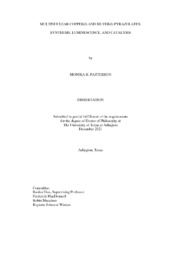
ATTENTION: The works hosted here are being migrated to a new repository that will consolidate resources, improve discoverability, and better show UTA's research impact on the global community. We will update authors as the migration progresses. Please see MavMatrix for more information.
Show simple item record
| dc.contributor.advisor | Dias, Rasika | |
| dc.creator | Patterson, Monika R | |
| dc.date.accessioned | 2023-06-28T14:42:38Z | |
| dc.date.available | 2023-06-28T14:42:38Z | |
| dc.date.created | 2021-12 | |
| dc.date.issued | 2021-12-08 | |
| dc.date.submitted | December 2021 | |
| dc.identifier.uri | http://hdl.handle.net/10106/31363 | |
| dc.description.abstract | Copper and silver pyrazolate complexes have numerous fascinating properties such as luminescence, catalytic ability, and complexation with small molecules. Using both more widely studied non-fluorinated pyrazolates and less common highly fluorinated pyrazolates as supporting ligands, we successfully synthesized and investigated several new coinage metal complexes. Synthetic details, structures, and properties i.e., luminescence and catalytic ability, have been studied.
Chapter 2 of this research describes the synthesis of a new pyrazole with highly fluorinated aryl groups and corresponding trinuclear copper(I), silver(I), and gold(I) complexes. All three metal complexes exhibit bright blue luminescence under exposure to UV light. Additionally, the copper(I) complex proved to be an excellent catalyst in azide-alkyne cycloadditions.
Chapter 3 discusses the synthesis and characterization of four new non- fluorinated copper(I) and silver(I) pyrazolates with ethyl ester substituents on the pyrazole ligand. These complexes were investigated as potentially cheaper and more common alternatives to highly fluorinated coinage metal complexes. Despite the electronic and steric similarities, these new non-fluorinated trimers were not found to exemplify the same properties as the previously reported fluorinated analogs.
Chapter 4 compares several trinuclear and tetranuclear copper(I) pyrazolates in copper catalyzed azide-alkyne cycloaddition reactions (CuAAC). Previous work has shown copper(I) trimers with fluorinated pyrazoles are excellent stand-alone catalysts for these reactions. In this chapter we found copper(I) trimers with less or non-fluorinated pyrazolates are poor catalyst. However, copper(I) tetramers, even with electron donating alkyl substituents on the pyrazole, are excellent catalysts. To gain further understanding, the solution behavior of several copper(I) trimers and tetramers are studied using vapor pressure osmometry and some kinetic experiments were performed.
Chapter 5 describes the synthesis of heteroleptic complexes using {[3,5- (CF3)2Pz]Cu}3 and bis(diphenylphosphinomethane). The resulting copper(I) pyrazolate complexes with bis(diphenylphosphinomethane) have interesting luminescent properties that could provide potential applications as an inorganic LED. | |
| dc.format.mimetype | application/pdf | |
| dc.language.iso | en_US | |
| dc.subject | Copper | |
| dc.subject | Silver | |
| dc.subject | Pyrazole | |
| dc.subject | Catalysis | |
| dc.subject | Luminescence | |
| dc.title | Multinuclear copper(I) and silver(I) pyrazolates: synthesis, luminescence, and catalysis | |
| dc.type | Thesis | |
| dc.date.updated | 2023-06-28T14:42:38Z | |
| thesis.degree.department | Chemistry and Biochemistry | |
| thesis.degree.grantor | The University of Texas at Arlington | |
| thesis.degree.level | Doctoral | |
| thesis.degree.name | Doctor of Philosophy in Chemistry | |
| dc.type.material | text | |
| dc.creator.orcid | 0000-0002-8794-8878 | |
| local.embargo.terms | 2023-12-01 | |
| local.embargo.lift | 2023-12-01 | |
Files in this item
- Name:
- PATTERSON-DISSERTATION-2021.pdf
- Size:
- 6.658Mb
- Format:
- PDF
This item appears in the following Collection(s)
Show simple item record


